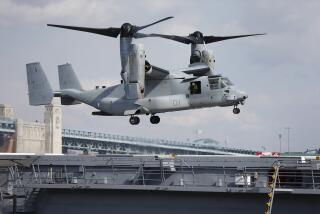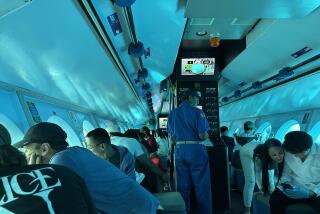Admiral Cites Equipment, Other Woes in Sub Crash
- Share via
PEARL HARBOR, Hawaii — The deadly collision between a U.S. submarine and a Japanese fishing vessel was caused by a series of equipment and personnel problems, capped by a sonar technician’s puzzling failure to provide information to the captain that could have averted the disaster, an admiral testified Monday.
Rear Adm. Charles Griffiths Jr., the Navy investigator, also told the court of inquiry that the submarine’s captain, running behind schedule to provide 16 VIPs aboard with a demonstration of a rapid surfacing maneuver, took only 80 seconds to scan his periscope to look for boats in the area.
If the Greeneville’s captain, Cmdr. Scott Waddle, had taken more time or brought his vessel closer to the surface to give the periscope more range, he might have spotted the trawler Ehime Maru, Griffiths said. A periscope inspection should take at least three minutes, to compensate for swells in the sea and other factors, the admiral said.
Also, a longer duration might have allowed the sub’s radar sensing equipment to detect the trawler, the admiral said. Instead, Waddle ordered a dive and then a rapid ascent known as an “emergency blow.”
The 6,500-ton submarine smashed into the trawler, sending it to the bottom of the ocean, killing nine of 35 people aboard the boat.
Testifying before a panel of three U.S. admirals charged with determining what caused the collision and whether criminal charges, or other punitive actions, should be filed against Waddle and two other officers, Griffiths outlined a series of problems that cumulatively led to the disaster.
Griffiths noted that a key display monitor in the sub’s control room that allows officers to see sonar information was broken.
One of the sonar operators was a trainee and his training officer had been assigned to act as a guide for the 16 civilians. The 16 were spending the day aboard the submarine as part of the Navy’s Distinguished Visitors public relations program.
Griffiths said that a fire-control technician--a senior enlisted man whose job is to interpret sonar data and provide information to the captain--had a sonar contact that indicated that a boat was within 2,000 yards of the sub. He never gave the information to Waddle or the officer of the deck, Lt. j.g. Michael Coen.
Griffiths said the technician told him that the civilians impeded his efforts to make an entry into a log. Also, the technician said he believed that the captain had spoken directly to the sonar technicians and had updated information.
“He kind of felt like he was being benched at that point of the game, incorrectly so,” Griffiths said. “He should have volunteered that information. . . . This is key information, and it didn’t get to the commanding officer or the officer of the deck.”
The court of inquiry, ordered by Adm. Thomas B. Fargo, commander of the Pacific Fleet, is expected to take several weeks to examine the arcana of submarining and to obtain testimony from Greeneville officers and crew members, the Ehime Maru’s captain and some of the civilians.
Griffiths voiced surprise that Waddle opted to continue his mission when a key display monitor failed.
“When I was a submarine CO and that piece of equipment was out, I felt naked,” Griffiths said.
One of the issues that the court is attempting to determine is whether the presence of the civilians contributed to the collision. Griffiths said there is no evidence that the civilians--including three who were operating controls--were responsible.
But he offered the scenario of a captain who, ordered by his superiors to show 16 VIPs a good time aboard his submarine but also get them back by dinner time, may have rushed several key maneuvers meant to assess whether there were any boats in the vicinity.
A 45-minute lunch with the civilians had put the submarine behind schedule, the court was told.
“He wanted to get to periscope depth in a hurry,” Griffiths said. “I can only surmise it was because they were late from their previous schedule.”
The collision has provoked outrage in Japan, including calls for criminal charges against Waddle and others. In an unprecedented move, Fargo is allowing a Japanese admiral to serve as an advisor to the court, including participating in the private deliberations of the three U.S. admirals. That brought a protest Monday from attorneys for Waddle, who accused Fargo, in his attempt to mollify the Japanese, of undercutting the rights of the submarine officers whose actions are under investigation.
Waddle’s attorneys were rebuffed in their attempt to question Rear Adm. Isamu Ozawa about his views of the incident and whether he is an official representative of the Japanese government. Japan has expressed outrage over the Navy’s handling of the case.
Fargo invited Ozawa--a submariner--to join the inquiry panel as a nonvoting member. In a sign of the geopolitical significance that the incident has acquired, Fargo ruled in ordering the court convened that Ozawa’s presence “is not open to challenge.”
As a result, Vice Adm. John B. Nathman, acting as president of the court, denied a request by Waddle’s attorneys to question Ozawa.
Among other things, attorney Charles Gittins had hoped to question Ozawa about a 1988 collision between a Japanese sub and a fishing trawler that led to the sub’s top officer facing criminal charges. Thirty people died, and the sub and trawler captains were given prison sentences, which were later overturned.
Such questioning could have helped determine whether the Japanese take a harder line toward collisions at sea, compared with the U.S. Navy, which rarely court-martials officers for such incidents.
In 1992, the U.S. Navy invited a Turkish admiral to advise a court of inquiry into an incident involving a destroyer mistakenly firing missiles at a Turkish ship. But the Turkish admiral was not allowed to join in the deliberations.
Gittins and the other attorneys indicated that they also plan to protest the fact that their clients were not advised of their legal rights before being interviewed by Griffiths and other investigators. Attorneys for Waddle, Coen and Lt. Cmdr. Gerald K. Pfeifer were allowed to question the admirals to see if they wanted to present a challenge to any of them. No challenges were mounted.
Nathman, asked if he thought it mandatory for a sub captain to face court-martial or other punishment in the case of a collision at sea involving loss of life, replied: “No, you’ve got to find out the facts.”
Six family members of those killed on the trawler attended the court session, along with three members of the Japanese Consulate in Honolulu. Family members of Waddle, Coen and Pfeifer also attended, sitting on the opposite side of the small courtroom.
In questioning the admirals, an attorney for Pfeifer indicated that his client had doubts about some of Waddle’s decisions that preceded his order for the rapid ascent but was reluctant to disagree with him in front of the crew and civilians.
More to Read
Sign up for Essential California
The most important California stories and recommendations in your inbox every morning.
You may occasionally receive promotional content from the Los Angeles Times.










